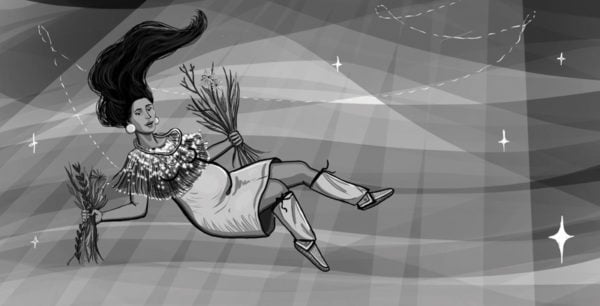When Monique Gray Smith first read Braiding Sweetgrass: Indigenous Wisdom, Scientific Knowledge, and the Teachings of Plants by Robin Wall Kimmerer in 2015, she could only read a couple pages at a time before having to put it down and “let everything find its rightful place.”
So, when Smith was asked to adapt Braiding Sweetgrass for young-adult readers, she was filled with tremendous gratitude. “What a blessing to work on this project,” recalls Smith. “What an immense responsibility to take what is a sacred text and be a bridge to make it available and accessible to young adults.”
Nicole Neidhardt, colleague, friend, and illustrator of the book, shared the sentiment. “It’s a special, beautiful book that does such a good job sharing a lot of the commonalities in Indigenous knowledge, especially plant knowledge. I was terrified, excited, and full of love to be able to illustrate it.”
Braiding Sweetgrass, which has become U.S. publisher Milkweed Editions’ most popular book to date, was written by Kimmerer in “response to the longing in Indigenous communities that our philosophy and practices be recognized as guidance to get us back on the path of life.” With 132 weeks on the New York Times bestseller list, its message of building a reciprocal relationship with all living beings has resonated deeply with readers.
Smith, an award-winning children’s author, had to strike the perfect balance between the three strands that make up the book – Indigenous wisdom, scientific knowledge, and teachings of the plants – using only a third of the word count of the original. “I couldn’t say, I’m going to cut this and cut that, because that felt very disrespectful to Robin and her writing,” Smith says. “Instead, I kept saying, [this is] what we’re saving for people when they read the original manuscript.”
Braiding Sweetgrass for Young Adults: Indigenous Wisdom, Scientific Knowledge, and the Teachings of Plants (Zest Books, out now) combines parts from its predecessor with a number of new additions including quotes, definitions, reflection questions, calls to action, and an introductory section entitled “Meeting Sweetgrass” that features the Haudenosaunee and Anishinaabe story of Skywoman Falling, illustrated by Neidhardt. This black-and-white illustration is one of many that appear throughout the book, each with hidden details for the discerning eye. Smith believes the illustration will prepare the reader’s heart to be engaged. “When the reader opens [the book], it’s almost like they enter a graphic novel,” she says. “The social-emotional learning and intelligence has always been in the manuscript. [We’ve] just put it out in another way where it’s really [at the] forefront.”

Illustration: Nicole Neidhardt
The history that Kimmerer wove into the original – including the Carlisle Indian Industrial School in Pennsylvania where her grandfather was sent and forced to leave behind his language, culture, family, and the land – is another illuminating element Smith gave emphasis to. “For some young readers this may be a gentle way to begin to learn about certain aspects of history they either might never have learned about, or they will learn a different element of truth,” Smith says.
Although the majority of the history in the book is specific to the United States, Smith encourages her young readers and adults to ask themselves about similar legislations, policies, or stories where they are living. “It’s easy for people to make that connection because colonial practices have occurred in every country; colonial legislation and policies have influenced Indigenous people, the climate, the land, and mutual thriving.”
Like the original, Braiding Sweetgrass for Young Adults focuses on the importance of all living things and offers lessons in mindfulness, gratitude, reciprocity, and language. For Smith, the journey to this way of living begins with love. “I think it’s about love for ourselves. I’m not saying that in an egotistical way. But, caring for ourselves so we can care for each other, so we can care for the Earth, so we can care for all living beings. If we aren’t caring for ourselves, it’s really hard to extend that care.”
“I hope the teachings of relationality come through for young readers. To understand that we are all in relation to one another, and to our plant relatives, animal relatives, and to the land, the water, the air – and with those relationships, there’s a responsibility to care for [them],” Neidhardt echoes. “Teachings that encompass relationality can change the way [young adults] not only think about themselves in the world but also how they can move through the world.”
Relationality also calls on us to turn away from our consumer-driven society, which has, says Smith, “fostered a craving for belongings with an s. But what people are really craving is belonging. It’s the reciprocal responsibility to make our own effort to belong and to invite [others] to belong. That’s part of why I’m excited about this manuscript coming to the young and the young at heart.”

 Contact us via email
Contact us via email

